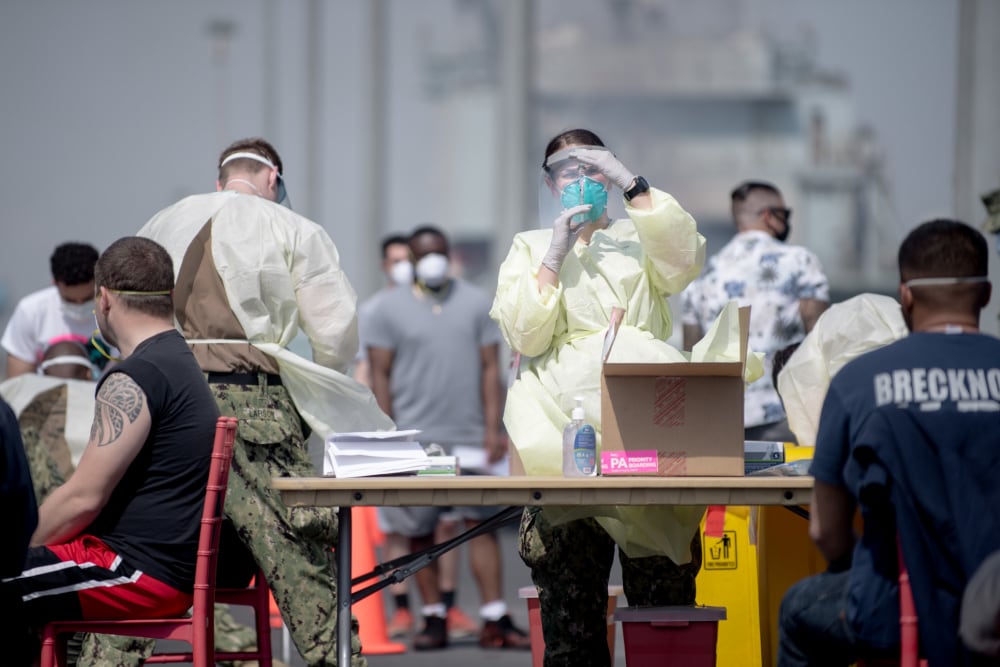The Defense Department expects to hit 3 million COVID-19 vaccine doses administered in the next several weeks, the head of the Defense Health Agency told reporters on Thursday. But it has been difficult to determine how many of those are going to troops, their family members or civilian employees.
During a briefing focused on vaccination of personnel deployed and stationed outside the contiguous United States, who don’t have access to the numerous pharmacies and public health departments inoculating the public back home, Lt. Gen. Ronald Place told reporters that the department has purposely sent about 14 percent of its doses OCONUS, earmarked for what amounts to 7 percent of its beneficiaries.
“I’m not prepared to answer specifically to the total OCONUS versus CONUS and what that might look like,” he told Military Times, adding, however, that the vaccination rate is about 10-to-15 percent higher overseas.
To streamline that process, DoD started prioritizing its Johnson & Johnson vaccines, which require one dose, to deployed and forward-deployed personnel.
Now, after a factory manufacturing that vaccine lost millions after failing quality controls, Place said DoD is looking for ways to back-fill its lost share of that batch.
Though the department has administered more than two million doses worldwide, getting fidelity on who has received them and how that affects military readiness has been a challenge.
Representatives from each of the military departments shared different sets of numbers Thursday.
The Army Department has administered more than 688,000 doses, according to Maj. Gen. Jill Faris, Army Medical Command’s interim director of operations, plans, and training, with about 461,000 fully vaccinated, to include troops, family members and Army civilians or contractors.
The Navy Department has vaccinated about 35 percent of its roughly 530,000 active-duty sailors and Marines, Deputy Surgeon General Rear Adm. Gayle Shaffer told reporters.
The Air Force Department reports that just over 11 percent of its force has received at least one dose, with 7 percent of its roughly 330,000 airmen and guardians fully vaccinated.
The Pentagon has struggled to provide updates on numbers of vaccinated troops. Under the Trump administration, it was policy not to disclose any more than the overall numbers reported to the Centers for Disease Control and Prevention, which appear on a tracking website that is not particularly up-to-date.
The department expects to open up its eligibility to all volunteers under 16 on April 19, in line with the White House’s goal for the U.S. in general. Currently, about 40 percent of its care facilities have already moved into that second phase, Place said.
The Army, Faris added, has tried to regulate its progress through the phases, by sending more doses to providers still working through first responders, deploying troops and those with pre-existing conditions, and reducing shipments to locations that have vaccinated their tier 1 personnel.
RELATED

DoD does not track the number of people who have been offered a vaccine but not taken it for one reason or another.
While those numbers are known a local level, because health care staff will often circle back to someone if they don’t schedule an appointment after their first notification, DoD doesn’t consider merely not scheduling an appointment to be a rejection of the vaccine.
Some troops are meeting with a doctor, discussing the risks and choosing not to get inoculated, while others have immediate scheduling conflicts that would prevent being able to get both doses from the same provider, per protocol. Still others have taken a wait-and-see approach before circling back at the next opportunity.
“As we move through those tiers, we know who accepted, who didn’t come in or didn’t try to make an appointment, that sort of thing. But when we know who’s gotten it, we circle back to those who haven’t and offer it again, on an iterative basis,” Place told reporters March 26. “And as we offer it, many who at first declined the opportunity are now taking us up on that opportunity.”
Because all three vaccines are under an emergency use authorization from the Food and Drug Administration, service members and other DoD employees are not required to take it.
The Pentagon has said it expects to have every volunteer fully vaccinated by this summer, and in the mean time, it has stuck with many of its virus prevention efforts. Troops are still able to deploy unvaccinated, subject to testing and quarantine protocols before their departures and return.
At some installations, previously closed indoor facilities like dining halls and gyms have opened up to personnel who show proof of vaccination.
Those decisions are up to those local commanders, Faris said, who have the authority to adjust their health protection levels according to the number of cases in their areas.
Meghann Myers is the Pentagon bureau chief at Military Times. She covers operations, policy, personnel, leadership and other issues affecting service members.




